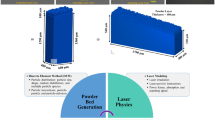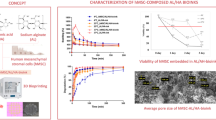Abstract
The combination of hydroxyapatite composite powder and three-dimensional (3D) printing rapid prototyping techniques has markedly improved skeletal interactions in orthopedic surgery applications. 3D printing methodology ensures effective bionic microstructure and shape interactions between an implant and the surrounding normal tissue. In effort to enhance the quality, precision, and mechanical properties of printed bone scaffolds, this study examines binder droplet spreading performance on the surface of hydroxyapatite (HA) microspheres. The piezoelectric nozzle diameter is about 10 μm, which sprays droplets 20 μm in diameter. The average size of HA powder particles is about 60 μm in diameter. Most laboratories, however, are limited to observation of a single droplet 20 μm or smaller in diameter impacting a spherical surface 60 μm in diameter. Based on non-dimensional scale similarity theory in axisymmetric Stokes flow dynamics, this study conducted experiments and simulation on the same collision conditions (droplet 200 μm in diameter, spherical surface 600 μm in diameter). Simulation results were consistent with experiment data, and form a basis for future research on modeling droplet impact on spherical surfaces.














Similar content being viewed by others
References
Chen Biqiong (2005) Mechanical and dynamic viscoelastic properties of hydroxyapatite reinforced poly(3-caprolactone). Polym Testing 7(24):978–979
Mooney DJ, Baldwin DF, Suh NP (1996) Novel approach to fabricate porous sponges of ply(d, 1-lactic-co-glycolic acid) without the use of organic solvents. Biomaterials 17(14):1417–1422
Felicity PR, Lesley AC, David MG et al (2004) In vitro assessment of cell penetration into porous hydroxyapatite scaffolds with a central aligned channel. Biomaterials 25(1):507–514
Feng Z, Rho J, Han S, Ziv I (2000) Orientation and loading condition dependence of fracture toughness in cortical bone. Mater Sci Eng 11(1):41–46
Lin ASP, Barrows TH, Cartmell SH, Guldberg RE (2003) Microarchitectural and mechanical characteri-zation of oriented porous polymer scaffolds. Biomaterials 24(3):481–489
Gibson LJ (2005) Biomechanics of cellular solids. J Biomech 38:377–399
Roux DCD, Cooper-White JJ (2004) Dynamics of water spreading on a glass surface. Colloid Interface Sci 277:424–436
Luo J, Qi LH, Zhou JM, Hou XH, Li HJ (2012) Modeling and characterization of metal droplets generation by using a pneumatic drop-on-demand generator. J Mater Process Technol 212:718–726
Pan KL, Tseng KC, Wang CH (2010) Breakup of a droplet at high velocity impacting a solid surface. Exp Fluids 48:143–156
Fujimoto H, Ogino T, Takuda H et al (2001) Collision of a droplet with a hemispherical static droplet on a solid. Int J Multiph Flow 27:1227–1245
Cao W, Miyamoto Y (2006) Freeform fabrication of aluminum parts by direct deposition of molten aluminum. J Mater Process Technol 173:209–212
Yarin AL (2006) Drop impact dynamics: splashing, spreading, receding, bouncing. Annu Rev Fluid Mech 38:159–192
Ge Y, Fan LS (2005) Three-dimensional simulation of impingement of a Liquid droplet on a flat surface in the Leidenfrost regime. Phys Fluids 17:027104
Xu L (2007) Liquid drop splashing on smooth, rough, and textured surfaces. Phys Rev E 75:056316
Wang Y, Chen S (2015) Droplets impact on textured surfaces: mesoscopic simulation of spreading dynamics. Appl Surf Sci 327:159–167
Kim CS, Park S-J, Sim W, Kim Y-J, Yoo Y (2009) Modeling and characterization of an industrial inkjet head for micro-patterning on printed circuit boards. Comput Fluids 38:602–612
Szucs T, Brabazon D (2009) Effect of saturation and post processing on 3D printed calcium phosphate scaffolds. Key Eng Mater 396–398:663–666. doi:10.4028/0-87849-353-0.663
Bakshi S, Roisman IV, Tropea C (2007) Investigations on the impact of a drop onto a small spherical target. Phys Fluids 19(3):03210201–03210212
Li YP, Wang HR (2011) Three-dimension direct simulation of a droplet impacting onto a solid sphere with low-impact energy. Can J Chem Eng 89:83–91
Bolster D, Hershberger RE, Donnelly RJ (2011) Dynamic similarity, the dimensionless science. Phys Today 64:42–47
Qing N, Saleh T, Todd FD et al (2002) Singularity formation in free-surface Stokes flows. Contemp Math 306:147–165
Shen SQ, Li Y, Guo YL (2009) Numerical simulation of droplet impacting on isothermal flat solid surface. J Eng Thermophys 30:2116–2118
Francois M, Shyy W (2003) Computations of drop dynamics with the immersed boundary method, Part 2: drop impact and heat transfer. Numer Heat Transf 44:119–143
Pasandideh-fard M, Qiao YM, Chandra S et al (1996) Capillary effects during droplet impact on a solid surface. Phys Fluids 8(3):650–660
Acknowledgements
This project is sponsored by the National Natural Science Foundation of China, (Grant Nos. 51175432 and 50905147), the Doctor Special Science and Technological Funding of the China Ministry of Education (Grant No. 20116102110046), the Fundamental Research Funds for the Central Universities (3102014JCS05007), and the graduate starting seed fund of Northwestern Polytechnical University (Grant No. Z2015074).
Author information
Authors and Affiliations
Corresponding author
Rights and permissions
About this article
Cite this article
Wang, Ye., Li, Xp., Li, Cc. et al. Binder droplet impact mechanism on a hydroxyapatite microsphere surface in 3D printing of bone scaffolds. J Mater Sci 50, 5014–5023 (2015). https://doi.org/10.1007/s10853-015-9050-9
Received:
Accepted:
Published:
Issue Date:
DOI: https://doi.org/10.1007/s10853-015-9050-9




